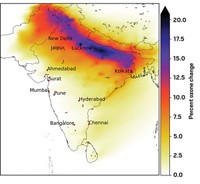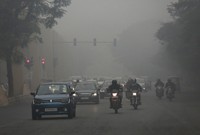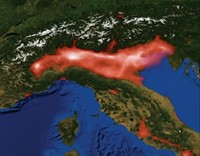Advertisement
Grab your lab coat. Let's get started
Welcome!
Welcome!
Create an account below to get 6 C&EN articles per month, receive newsletters and more - all free.
It seems this is your first time logging in online. Please enter the following information to continue.
As an ACS member you automatically get access to this site. All we need is few more details to create your reading experience.
Not you? Sign in with a different account.
Not you? Sign in with a different account.
ERROR 1
ERROR 1
ERROR 2
ERROR 2
ERROR 2
ERROR 2
ERROR 2
Password and Confirm password must match.
If you have an ACS member number, please enter it here so we can link this account to your membership. (optional)
ERROR 2
ACS values your privacy. By submitting your information, you are gaining access to C&EN and subscribing to our weekly newsletter. We use the information you provide to make your reading experience better, and we will never sell your data to third party members.
Pollution
Peering into China’s thick haze of air pollution
Scientists are teasing out which emissions contribute most and the chemical reactions that create smog filled with particulates
by Hepeng Jia and Ling Wang, special to C&EN
January 23, 2017
| A version of this story appeared in
Volume 95, Issue 4

As 2016 gave way to 2017, residents of Beijing, Tianjin, and many other northern Chinese cities suffered through the longest stretch of stifling air pollution ever recorded in the country. They choked through eight continuous days of thick, light-blocking haze, starting Dec. 30, 2016. This stretch of bad air began only a week after people in 70 northern Chinese cities were enveloped by similar days of haze composed of high concentrations of particles less than 2.5 μm in diameter (PM2.5).
Also known as ultrafine particulates, PM2.5 consists of solids and liquids. Its sources include black carbon from incomplete combustion as well as sulfates and nitrates. Levels of such ultrafine particles surpassed 500 μg per cubic meter of air in both of the recent incidents in China.
That level is twice the daily concentration of 250 µg/m³ that the U.S. Environmental Protection Agency considers hazardous to human health. In contrast, few U.S. cities recorded an air quality index of above 50, which can be translated to a PM2.5 concentration of 12 µg/m³, during the recent days that northern China’s air was filled with haze, according to EPA data.
The recent bouts of toxic smog sent tens of thousands of residents fleeing Beijing and other northern Chinese cities for cleaner air abroad or in southern China. Angry protests and bitter jokes flooded WeChat and Weibo, China’s most popular social media. The complaints about the government’s failure to deal with dangerous air pollution, however, fail to take into account the complicated haze situation and the largely unknown mechanisms that create the pollution.
Geography plays an important role in northern China’s air pollution. The Beijing-Tianjin-Hebei region is surrounded by mountains which block diffusion of the haze. The pollution becomes worse during winters, said Yuesi Wang, a leading scientist at the Beijing-based Institute of Atmospheric Physics (IAP), which is part of the Chinese Academy of Sciences (CAS). Speaking at a forum held in November 2016 in Beijing, Wang explained that weather factors—such as high humidity and situations when warmer air aloft holds colder air at the surface—intensify haze formation. In winter, slower air flow and stable atmospheric outer layers—which inhibit smog diffusion—plus the burning of coal for indoor heat result in much more hazy days than in other seasons.

a Data through Dec. 27, 2016.
Sources: Compiled from reports from China, Beijing, Tianjin, and Hebei and websites of local environmental protection bureaus
Although China has suffered serious air pollution for decades, attention to air pollution in northern China initially was focused on sulfates and nitrogen oxides as well as larger particulate matter called PM10. The latter consists of particulates less than 10 μm in diameter, primarily wind-carried dust from construction sites and sand storms.
Only recently has attention centered on PM2.5, which accounts for 70% of PM10 and can combine with vapor in the air to form what is called smog or haze. China started regularly measuring PM2.5 in 2012 and began releasing data on it in 2013.
Those data suggest that emissions of fine particulates are the biggest source of northern China’s haze. A report on the 2015 state of the environment issued by the Chinese Ministry of Environmental Protection last year indicates that air quality in 265 of the 338 major Chinese cities exceeded the national health standard that year.
Coal burning for heat, cooking, and electricity generation, vehicle emissions and airborne dusts are widely considered the main sources of both PM2.5 and other pollutants. According to Wang, the majority of PM2.5 comes from complicated photochemical reactions between numerous sulfates, nitrogen oxides, and other inorganic and organic chemicals.
Polluting particulates smaller than 2.5 μm can enter human cells and cause serious health hazards. For example, such tiny particles can have significant negative respiratory effects. A 2016 study also found that for every 5 µg/m³higher concentration of PM2.5, there was a 20% increase in the rate of coronary artery calcium deposits, leading to a higher risk of coronary diseases (Lancet, 2016, DOI: 10.1016/s0140-6736(16)31597-5). Another study found that for every 5 µg/m³ higher concentration of PM2.5, the risk of hypertension increased by 22% in people living in the most polluted areas (Eur. Heart J., DOI: 10.1093/eurheartj/ehw413).
Although the data in these studies are not specific to China, a study on the global burden of disease found that outdoor air pollution contributed to 1.2 million premature deaths in China each year, making it the fourth leading risk factor for deaths after dietary risks, high blood pressure, and smoking. That study was carried out by the Institute for Health Metrics and Evaluation at the University of Washington and released by the World Health Organization in 2013.
Northern China’s current haze problem stems from recent changes in the region: the accelerated development of heavy industries, the surge in coal burning associated with them, and increased car ownership.
“The coal consumption per kilometer in the Beijing-Tianjin-Hebei region is 30 times the world’s average, which is the primary driving factor of PM2.5 and haze,” said Xiangwan Du, deputy director of China’s National Advisory Committee for Energy Policy. In 2015, the region consumed 400 million metric tons of coal, according to a book published last year by the China Energy Research Society.
A 2013 national action plan strengthened existing policies requiring control of two major types of air pollution—sulfur oxides and nitrogen oxides—from power plants and other heavy users of coal. But these efforts are not enough to curb the emission and formation of PM2.5, said Xinmin Zhang of the Chinese Research Academy of Environmental Sciences (CRAES).
“To fight the serious haze, overall coal consumption and pollutant emission must be dramatically reduced,” Fuqiang Yang, a senior adviser to Natural Resources Defense Council (NRDC), a U.S.-based environmental group, told C&EN.
In response to the situation, the Beijing municipal government has imposed a strict car-control policy—it uses lottery draws to control new car ownership and limits how many cars are on the road on any given day—and banned coal burning in its urban areas since 2012. Yet the heavy coal consumption in neighboring Hebei province easily overshadows the effects of Beijing’s policy as air pollution drifts across the region.
Facing strong public pressure, China’s government began to implement its Action Plan on Prevention & Control of Air Pollution in 2013. In the plan, the government pledged to slash coal consumption from around 67% of the nation’s total energy use in 2012 to 65% by 2017. It also vowed to reduce PM2.5 levels by 15–25% by 2020. Under this policy, thousands of polluting factories were shut down, particularly in north China.
Despite these strict national policies on air pollution control, northern China’s haze hasn’t fully lifted. According to Report of the State of the Environment in China 2015, the 74 Chinese cities tracked in accordance with the action plan, which include all provincial capitals and other large cities, the average PM2.5 concentration in 2015 was 55 µg/m³, a 14.1% reduction from 2014. In the Beijing-Tianjin-Hebei region, the average annual level of PM2.5 was 77 μg/m3 in 2015, down from 106 µg/m³ in 2013. In 2015, Beijing recorded 42 days of the highest polluting days (defined as those with a PM2.5 concentration of more than 500 µg/m³), three days fewer than 2014.
To demonstrate to the world its capacity to deal with air pollution, China adopted emergency air pollution control measures before and during the weeklong November 2014 Asia-Pacific Economic Cooperation (APEC) summit held in Beijing. Thousands of industrial plants were temporarily closed even though they met emission standards. Average concentrations of PM2.5 fell to 37 µg/m³ during the meeting and long-blocked blue sky reappeared in Beijing. However, brown haze chased away the blue after the summit when the plants restarted.
Because of their shutdowns for APEC, industries in Beijing, Tianjin, and Hebei province had losses of 3.5 billion yuan ($500 million), said Zhang of CRAES. The central and local governments reimbursed companies and rural residents who were banned from burning coal during the APEC meeting for most of their financial losses.

Zhang said that to permanently improve air quality in Beijing, more plants in Hebei province have to be closed. But, she admitted, this would entail huge costs and the loss of many jobs. “Local governments in Hebei province cannot afford the cost, yet the much richer Beijing municipal government refused to offer enough compensation to Hebei.”
Although the overall efforts to curb pollution are escalating, many facilities have tried to cut costs and evade strict emission limits by covertly shutting down their air pollution controls, often at night. There are no accurate estimates of how much these illicit emissions contributed to long-term pollution and the corresponding haze. However, websites of environmental regulation agencies at different levels of government indicate that virtually every pollution inspection by regulators in recent years detected dozens of such illegal emissions.
Climate change also factors into the formation of haze. “With global warming, the temperature difference across the north hemisphere is dramatically reduced, resulting in less wind, particularly in winter,” said Linsheng Yang, a senior scientist at Institute of Geographic Sciences and Natural Resources Research under CAS. He told C&EN that global warming may help explain why residents continue to report serious haze despite the decrease in pollutant concentrations.
NRDC’s Yang suggested the government tackle haze and climate change together. “Reducing carbon emission can reduce PM2.5 concentration at the same time,” he said. Yet he worries that economic stimulus policies aimed at improving the slowed-down Chinese economy—such as looser monetary policies, heavy investment in infrastructure, and growth in construction, which boosts steel and cement production—could raise energy consumption in the second half of 2017.
“Perhaps this explains why after a recordable reduction of PM2.5 concentration in [the past] three years, residents in northern Chinese cities experienced increased haze this winter,” he told C&EN.
Yang also appealed for more regional coordination to fight haze. “While the public and policy attention are focused in Beijing-Tianjin-Hebei region, the coal consumption in other neighboring provinces such as Shandong is increasing and may offset Hebei’s effort to slash the production capacity of heavy industry.” Located to Beijing’s southeast, Shandong province is home to one of the biggest concentrations of chemical manufacturing in China.
The policy limiting cars in Beijing might also be backfiring. Jing Tian, cofounder of the Beijing-based organization Clear Air Defense, told a seminar in December 2016 that the reduced emissions from cars in Beijing could be offset by the 100,000 diesel-engine trucks in use in the city’s outskirts. A diesel truck with a nonworking emission controls can contribute tens of times the pollutants of an average car.
Although diesel trucks might be a bigger culprit for forming haze, the 5.7 million vehicles in Beijing remains a primary contributor of PM2.5 in the capital city, said Yan Ding of MEP. Those vehicles contributed 31% of the city’s fine particulates in 2015, according to Beijing’s Environmental Statement for 2015,
But not everyone is convinced that vehicles in Beijing are the primary cause. In 2013, a team headed by Renjian Zhang at IAP published a study claiming vehicle emissions contributed only 4% of the identifiable sources of PM2.5 in Beijing, (Atmos. Chem. Phys., DOI: 10.5194/acp-13-7053-2013). This estimate differs significantly from the official figure of 31%. The study by Zhang’s team led to a huge public protest against car control policy in Beijing in late 2013. The Beijing municipal government and CAS scientists rejected the study’s result.
Despite the official rejection of the study, “it highlights the great uncertainty of source attribution of PM2.5,” said an atmospheric scientist based in Guangzhou who asked not to be identified because of fear of political repercussions.
A newly published follow-up study by IAP’s Zhang and colleagues further confirmed the uncertainty in attributing the source of PM2.5. According to the study, using different models, researchers found that the contribution of the primary sources of pollutants—including industrial pollution, soil dust, biomass burning, traffic emissions, and coal burning—changed dramatically. How much each contributed varied widely in the models (Sci. Tot. Environ., 2015, DOI: 10.1016/j.scitotenv.2015.11.057).
Advertisement
Though uncertainties remain in the source of PM2.5, other atmospheric chemistry studies have shed light on the mechanism of serious haze formation. Researchers have found an unexpectedly high level of sulfates, which are a major component of PM2.5, in China. Formation of sulfates was thought to rely on a photochemical reaction. That means northern China’s sun-blocking haze should have dramatically reduced the available light for the necessary reaction.
A team headed by Kebin He of Tsinghua University and their German colleagues found that instead of relying on photochemistry, the sulfates were rapidly formed by oxidization of SO2 by NO2 in an environment with a high level of aerosolized water. In a recent paper, the team concluded that northern China’s haze amplifies itself and that cutting NO2 emissions is important to reduce the formation of sulfates (Sci. Adv., 2016, DOI: 10.1126/sciadv.1601530).
Another international team, led by Gehui Wang of CAS’ Institute of Earth Environment and Renyi Zhang of Texas A&M University, found that nitrogen dioxide converts sulfur dioxide to sulfates via an aqueous oxidation mechanism. Their study showed that this transformation, which they suggest played a role in 1952’s historic London Fog as well as in contemporary Chinese haze events, occurs efficiently only on nonacidic particles (Proc. Nat. Acad. Sci., 2016, DOI: 10.1073/pnas.1616540113).
The conditions that led to these events differed, however. The 1952 event, which happened at a time when widespread coal burning in London polluted its air with SO2, started on cloud droplets. “But northern China’s haze starts from much smaller nanoparticles, and the sulfate formation process is only possible with ammonia to neutralize the particles,” Zhang told C&EN. “Our results suggest that controlling NO2 and NH3 emissions is likely effective to reduce severe haze in China, in addition to controlling SO2.”
Seeking to better understand the strengthening of northern China’s haze even as pollution controls tightened, Min Hu of Peking University, Renyi Zhang of Texas A&M, and their teams took a look at black carbon, which is a pollutant that contributes both to haze and global warming and is a major component of PM2.5. They studied how black carbon’s morphology can change from its newly emitted fractal form into compact particles with greatly enhanced light-absorbing characteristics.
They found the morphology modification of black carbon took just 4 to 6 hours in Beijing—four times as quickly as in Houston, which has cleaner air. Beijing’s rapid-aging black carbon particles with their enhanced light absorption could contribute to stabilization of the atmosphere, leading to formation of more severe haze events.
“Our studies indicate that already polluted urban environments and polluting particulates could interact to cause a multiplication of the haze effect. To tackle Beijing’s haze, researchers should not only study primary pollutants but their complicated interaction with atmosphere,” Zhang told C&EN.
Ozone is the primary air pollutant in Houston, which was used as a comparison in the Peking-Texas A&M study.
Although the clean air effort in Beijing currently is focused on PM2.5, ozone pollution is increasing in Beijing and some other Chinese cities because of the increased emission of nitrogen oxides and volatile organic compounds (VOCs) mainly from vehicles in recent years, said Wang of IAP.
Shiqiu Zhang, a professor of environmental governance at Peking, points out that the government does not require control of VOC emissions. “When dealing with PM2.5, policymakers and researchers should coordinate their efforts to fight other pollutants to avoid unexpected environmental effects,” she told C&EN.
CORRECTION: This story was updated on Feb. 13, 2017, to correct the unit of the measurement PM2.5 in the graphic, which was incorrectly stated as mg per m3 of air. The unit is μg per m3 of air. The story also incorrectly made a reference to an air pollutant as carbon black. The pollutant is black carbon.
Hepeng Jia and Ling Wang are freelance writers reporting from Beijing.





Join the conversation
Contact the reporter
Submit a Letter to the Editor for publication
Engage with us on Twitter